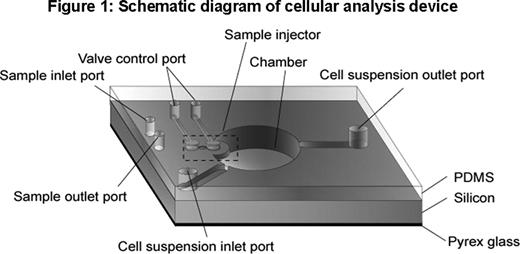Abstract
Abstract 2766
γδT cells, which control the innate immune system, are classified into three subtypes on the basis of Vγ chain. Of these subtypes, Vγ2Vδ9 T cells display anti-tumor immunity. We have demonstrated that nitrogen-containing bisphosphonate (N-BP) treatment expands Vγ2Vδ9 T cells ex vivo and that these expanded cells can kill tumor cells in a major histocompatibility complex-unrestricted manner (Sato, Int J Cancer, 2005; Uchida, Biochem Biophys Res Commun, 2007; Sato, Cancer Immunol Immunother, 2008.). N-BP inhibits farnesyl pyrophosphate synthase in the mevalonate pathway, resulting in the accumulation of isopentenyl pyrophosphate (IPP), which is a stimulatory antigen for Vγ2Vδ9T cells. In the present study, we investigated the chemotactic factors for Vγ2Vδ9T cells by using a micro total analysis system-based microfluidic cellular analysis device (Kanai, Sens Actuators A, 2004; Munaka, Analyst, 2007.). This microchip possesses a minute-volume (240 nL) chamber integrated with a micro-sample injector that permits the injection of a small amount (several nL) of a solute (Figure 1). Because of the minute size of this chamber, a concentration gradient can be maintained free from the influence of fluid convection and stirring, and the solute can consequently spread in a diffusion-dependent manner. Therefore, administration of a humoral factor via the sample injector mimics its release from the cell surface. We first investigated whether the supernatant of RPMI8226 multiple myeloma (MM) cells treated with zoledronic acid (ZOL) induced chemotaxis of γδT cells. We treated RPMI8226 MM cells with ZOL (1 mM) overnight and collected the supernatant. Human γδT cells were obtained by the culture of peripheral blood mononuclear cells as previously reported (Uchida, Biochem Biophys Res Commun, 2007.), and these cells were cultured in the microchip. After the injection of supernatant, γδT cells migration was observed under a microscope and continuous time-lapse recording was performed for 30 min. γδT cells migrated toward the injector, indicating that the supernatant of ZOL-treated RPMI8226 cells includes a chemoattractant factor for γδT cells. We next applied soluble MICA (sMICA), sICAM-1, sVCAM-1, and IPP and examined the migration of γδT cells. Among them, sMICA and IPP were chemoattractive for γδT cells, and the velocity of γδT cell migration was increased by the injection of IPP compared to the solvent control (Figure 2). These observations indicate that IPP, a metabolite of the mevalonate pathway in MM cells, or sMICA is a chemotactic factor for γδT cells when the target MM ells are treated with ZOL.
Munaka:Shimadzu Corporation: Employment. Kanai:Shimadzu Corporation: Employment. Abe:Shimadzu Corporation: Employment.
Author notes
Asterisk with author names denotes non-ASH members.



This feature is available to Subscribers Only
Sign In or Create an Account Close Modal